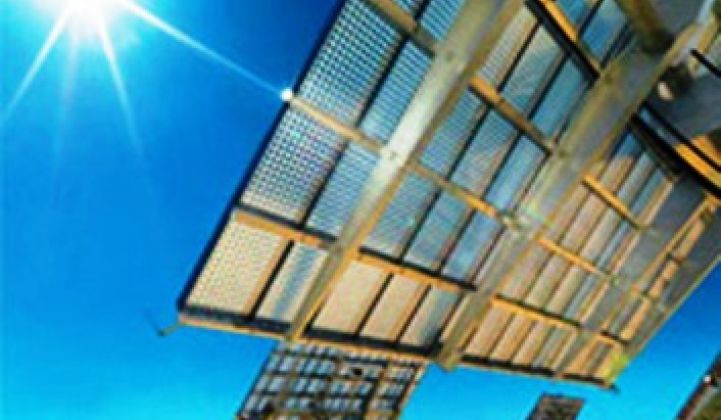Soitec, the French-headquartered CPV manufacturer, just scored $25 million from the DOE's SUNPATH program to help to support its new North American solar manufacturing facility in San Diego, California.
SUNPATH, a nice acronym, stands for the awkwardly named "Scaling Up Nascent PV At Home" and is intended to foster a competitive American solar manufacturing base. Soitec's new 176,000-square-foot factory on 15 acres is meant to support CPV projects in the San Diego and Imperial County region with a 200-megawatt capacity of Soitec's CPV systems.
The factory is under construction, is creating hundreds of jobs, and "the first phase is scheduled to be operational by the fourth quarter of 2012," according to a release from the company. Solar Junction and 1366 Technologies also received funding as part of the SUNPATH program.
Soitec shipped only two megawatts in 2010. But 2011 and 2012 saw the company win a lot of backlog and some hope for large-scale construction in 2012 and beyond. Last year Soitec raised a $212 million "capital increase" of which half to two-thirds was to be devoted to the CPV efforts of the firm.
Here are some of Soitec's recent accomplishments and announcements:
- Soitec completed construction and grid connection for a 1.1-megawatt power plant in Italy, the largest CPV solar farm in that country.
- A 150-megawatt CPV solar power plant, known as Imperial Solar Energy Center (ISEC) West, will be built on a 1057-acre former farmland site in Southern California’s western Imperial County on BLM land; completion is targeted for 2015.
- Five projects totalling 155 megawatts with SDG&E
- A 10-megawatt project in Morocco currently under an MOU
- 50 megawatts awaiting a PPA in a South African project (Soitec is doing its own project development in this instance). Soitec has already installed 560 kilowatts in South Africa.
So -- Soitec has a substantial backlog and claims a 30 percent module efficiency for its most recent generation product.
But the future of CPV is still murky.
On one hand, Vijit Sabnis, VP of Technology and a co-founder of triple-junction solar cell manufacturer Solar Junction, asserts that no other photovoltaic technology has the headroom to improve its efficiency like CPV's triple-junction solar cells. He also asserts that because T-J cells are a smaller proportion of the system bill of materials, no other cell technology's improvement can leverage down the cost of the system like CPV. Sabnis cited research that showed CPV to have the potential to achieve the lowest cost of electricity in hot, sunny, high-DNI regions with single-axis c-Si as CPV's largest competitor. Sabnis also cited several studies showing 70 percent theoretical efficiencies from a 5- or 6-junction cell. More practically, he sees 50 percent cell efficiency achievable in three to five years, which could get DC module efficiencies to over 40 percent.
On the other hand, as Brett Prior, a solar analyst formerly with GTM Research, said "Cheap PV is killing CPV." And flat panel pricing continues to fall even while performance slowly improves.
CPV solar system manufacturers such as Soitec, SolFocus, Amonix, Emcore, Semprius and GreenVolts are attempting to navigate this rocky market.
The largest CPV deployment in the world is the 30-megawatt Alamosa site in Colorado, with hardware from Amonix. The 5-megawatt Hatch site in New Mexico was the largest in North America until Alamosa came on-line. We have received unconfirmed reports that both of those sites are performing at less than rated power. SolFocus has a 50-megawatt project in development in Mexico.
So great technological progress is being made at the CPV cell level by Solar Junction, Semprius, JDSU, Encore, and Spectrolab, but system vendors have to cut cost at the systems level in order to compete with the plummeting cost of single-axis c-SI.
And c-Si has a big head start -- and the advantage of enormous scale.



